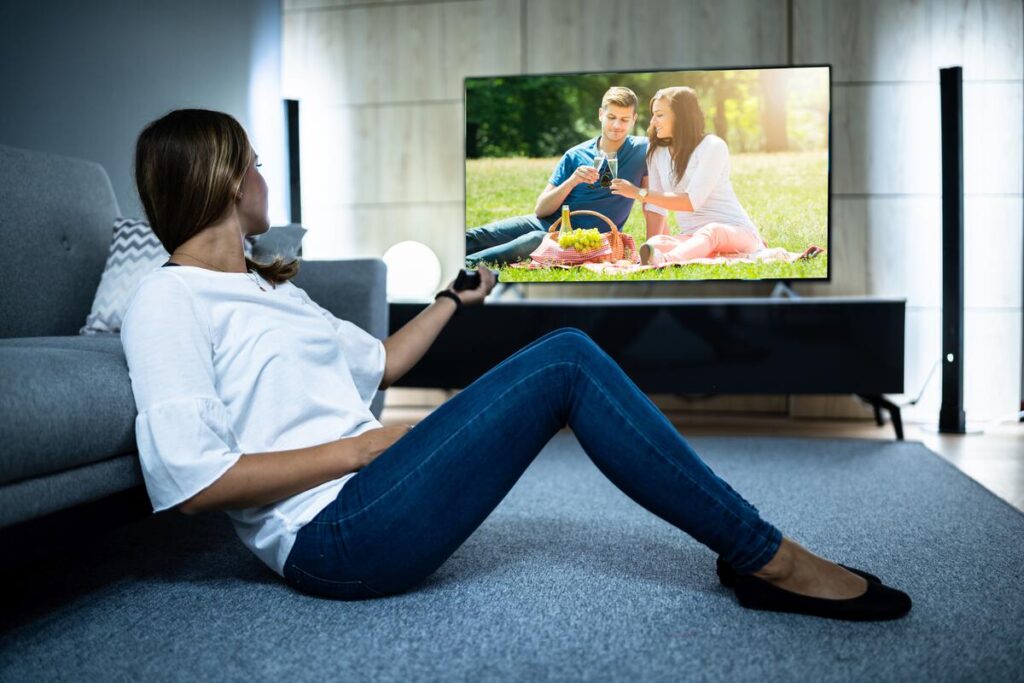Are LED TVs Anti-Glare? (Explained For Beginners)
Disclosure: Tech Parasol is supported by its readers. When you purchase through links on our site, we may earn an affiliate commission. Thank you.
- Some LEDs TVs such as Samsung QLED TVs have anti-glare coatings.
- Most LED TVs have glossy coating that can cause mirror-like reflections.
- LEDs with a semi-gloss finish and a high peak brightness perform the best in brightly lit environments.
There’s nothing more annoying than watching TV and seeing your own reflection or the glare from the sun coming from a nearby window.
You could just shut the curtains or blinds. But who wants to sit in the dark watching TV during the daytime?
So, in this article, we look to see if the latest LED TVs have anti-glare or not.
I’ve also done some research into which LED TVs are the best for bright rooms.
So let’s get started.
Here’s whether LED TVs are anti-glare:
Some LED TVs like Samsung QLEDs have a special coating on the screen to reduce glare and reflections. But most LED TVs, and especially high-end TVs, have glossy finishes which can cause mirror-like reflections in bright rooms.

What coatings/finishes are used on LED TV screens?
TVs in general have different ways of managing reflections and glare. This largely comes down to material the manufacturer uses for the screen’s finish.
Most modern TV screens are glossy causing them to act like a mirror whilst others have anti-reflective coatings.
But some anti-reflection coatings can produce a rainbow-like effect on the screen, which some users may find more distracting than reflections themselves.
But this is somewhat less visible when the screen is turned on.
The finish on a TV screen alone isn’t always enough to prevent reflections and glare. Especially if your room is very challenging (i.e. it has lots of light sources).
You also want a TV that has a high peak brightness.
A bright TV in combination with a semi-gloss finish will give you the best results in any brightly lit environment.
A matte finish is the third type of coating.
This finish spreads the light across the entire screen, reducing the reflections.
The downside is that matte screens aren’t as clear and the blacks look more washed out.
So TV manufacturers don’t tend to use them. But you will see these finishes on computer monitors.
Many high-end TVs have glossy screens. So bear that in mind if you’re looking for a new TV to put in your brightly lit room.
Another thing to bear in mind is that it’s not always obvious from the specifications whether a TV has a glossy or semi-gloss screen.
But you can generally tell if a screen is glossy because they tend to have more direct reflections.
Is a matte screen and anti-glare the same thing?
Matte screens and anti-glare aren’t exactly the same thing.
But matte screens have an anti-glare coating applied to them which helps a lot with reflections.
If you’re in a bright room, matte displays are much easier to see, despite direct sunlight from windows or light from nearby lamps.
The downside is that the display can appear dull and hazy.
Glossy displays are more vivid, have better contrast and produce deeper blacks.
But reflections on glossy screens can be really noticeable and potentially make the picture unwatchable in bright environments.
Do LED TVs reflect light?
All TVs including LED TVs reflect some amount of light.
So if you’re watching TV in a bright room, then you won’t be able to totally avoid reflections.
But that’s not to say that the screen reflects all the light.
Some of the light is absorbed and the rest is reflected.
Not all TVs reflect light in the same way either.
TVs with a glossy finish tend to reflect light back to the source, so it looks like a mirror. But they produce a more vivid picture quality.
TVs with a semi-gloss finish reduce the reflections but can make the picture look more hazy.
Are LED TVs suitable for bright rooms?
LED TVs are suited to bright rooms because the LED backlights in them allow the screens to get very bright.
Modern LED TVs have a high peak brightness. For example the Samsung QN90A QLED can get as high as 1,800 nits.
Because LED TVs can get really bright, they can help with any annoying glare or reflections that may distract you whilst watching the TV.
OLED vs LED for anti-glare
When it comes to anti-glare, LED TVs win hands down, simply because they can get much brighter.
Brighter TVs tend to do a better job of warding off distracting reflections.
The best LED TVs easily outshine OLED TVs. The main reason for this is the pixels in OLED TVs are individually lit.
As a result, OLED screens show more reflections, compared to an LED TV.
If you watch a lot of TV during the daytime in a room where there’s a lot of direct sunlight, then you’re better off with an LED TV.
If on the other hand, you mainly watch TV in the evening in a darkened room, you don’t need a TV to get so bright.
So an OLED TV would be a better choice.
OLEDs produce a much better quality picture than LED TVs.
They have a better contrast ratio because the individual pixels can be turned off completely, producing deep blacks.
So as long as you don’t have lots of lights shining, you’re going to get some stunning images.
The bottom line is that the environment you put your TV in is very important.
Check out the video below which compares OLED TVs and LED TVs in different environments:
Are QLED TVs good for anti-glare?
Samsung QLED TVs are excellent for anti-glare.
They have technology built into them that mimics the structure of a moth’s eyes (according to Tech Guide, Australia).
The technology consists of tiny uniform bumps that help to absorb and redirect external light that hits the screen.
This helps to reduce glare and reflections that can get very annoying when watching TV during the daytime.
Do LG TVs have anti-glare?
LG OLED TVs have a ‘discomfort glare free’ certification meaning that they emit no glare.
This is despite the fact that OLED TVs aren’t able to get as bright as LED TVs. (Tech Radar).
What are the best LED TVs for anti-glare?
The best LED TV for anti-glare, and therefore bright rooms, is the Samsuing QN85A QLED (according to Rtings).
The Samsung QN85A QLED uses mini-led backlighting enabling the screen to get extremely bright.
The QN85A also handles reflections extremely well, so it should work well in almost any brightly lit environment.
A budget friendly alternative would be the Hisense U6G.
This has excellent reflection capabilities and is capable of getting very bright.
Although it doesn’t perform quite as well as the QN85A in direct sunlight or outside.
How do I know if an LED TV is anti-glare?
Most, if not all modern LED TVs have a glossy or semi-gloss finish.
Some older TVs such as the Sharp LC-LE640U series and the Toshiba L5200 series have matte screens.
But TVs don’t have these finishes any more.
Modern Samsung QLED TVs have a special anti-reflection filter that counteracts reflections.
How to reduce glare on LED TVs
Here are some tips to reduce glare on LED TVs:
- Position the TV so that there is no direct light shining on the TV.
- Increase the backlight brightness.
- Position a lamp behind the TV to raise the ambient light in the room without seeing reflections. This is known as bias lighting. It’s important to use a neutral color here since the color used will subtract that color from the TV.
- If the TV is wall-mounted, you can try tilting to direct the reflection elsewhere. The downside is that the picture won’t look as good when looking at it from an angle.
- Use blinds or net curtains to block out the light.
Sources
Get rid of annoying TV glare with these 5 tricks
Reflections on TVs: Glossy and Semi-Gloss Finishes
What Is An Anti-Glare Screen? [Simple Guide]
Why Samsung’s QLED TV anti-glare technology suits our Australian homes
New LG OLED TVs are ‘glare free’ – but does it matter?

Robert Anderson
Robert Anderson, the founder of Tech Parasol, had a keen interest in tech from a very young age. He studied Electronic Engineering at University and then went on to become a Software Developer. He launched Tech Parasol in 2021 to share his knowledge with the aim of making tech easier to understand for everyone.

